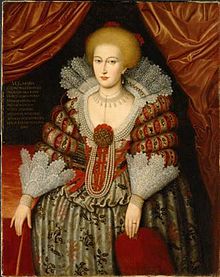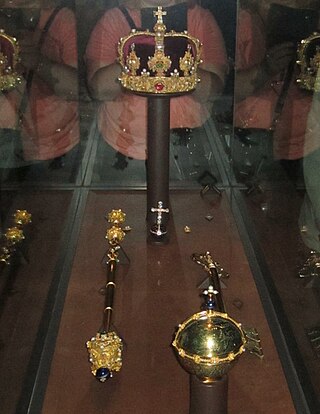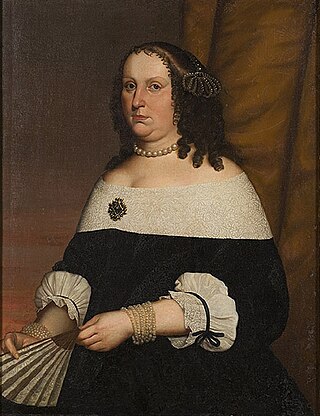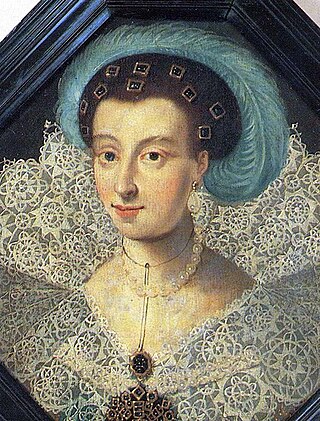This article relies largely or entirely on a single source .(July 2015) |


The wedding between Gustav II Adolf of Sweden and Maria Eleonora of Brandenburg took place at the Royal Castle on November 25, 1620.
This article relies largely or entirely on a single source .(July 2015) |


The wedding between Gustav II Adolf of Sweden and Maria Eleonora of Brandenburg took place at the Royal Castle on November 25, 1620.
The bridal entourage began its journey at 9.30 in the morning on November 25. In the bridal carriage was Maria Eleonora who just turned 21, and her mother Duchess Anna of Prussia. The bridal train started at Bergshamra outside of Stockholm, and in it was the bride's sister and aunt, eight maids, seven junkers and many carriages, amongst others. The train was greeted by Gustav II Adolf's impressive entourage when they reached Stockholm. The king himself came up to the bride's carriage together with Axel Oxenstierna to greet her. The bridal train continued to The Royal Castle, where the king's mother Christina of Holstein-Gottorp and the old dowager queen Catherine Stenbock met them. [1]
In the afternoon on November 25 the bride and the groom were brought in a procession to the hall of state at the Royal Castle. First came the marshal Svante Banér and six timpanists. After them came a long line of noblemen, privy councils and more timpanists. Then came the bridal couple, followed by their mothers. [1]
Archbishop Petrus Kenicius officiated the wedding in Swedish. After that, the couple were taken to their nuptials in a red gold-embroidered velvet bed. There the bridal couple got to eat confectionery, listen to speeches and drink wine. The hall of state was converted and made up for the wedding dinner. The festivities were ended, as they should, with the newly weds dance. [1]
Maria Eleonora was crowned three days later in Storkyrkan in Stockholm. The festivities continued the days after the wedding and the coronation, for instance with a wedding tournament. [1]

Maria Eleonora of Brandenburg was Queen of Sweden from 1620 to 1632 as the wife of King Gustav II Adolph. She was born a German princess as the daughter of John Sigismund, Elector of Brandenburg, and Anna, Duchess of Prussia, daughter of Albert Frederick, Duke of Prussia.

Drottningholm Palace, or Drottningholm, one of Sweden's Royal Palaces, situated near Sweden's capital Stockholm, is the private residence of the Swedish royal family.

Prince Charles Philip of Sweden, Duke of Södermanland, (Swedish: Carl Filip; Reval 22 April 1601 – Narva, 25 January 1622) was a Swedish prince, Duke of Södermanland, Närke and Värmland. Charles Philip was the second surviving son of King Charles IX of Sweden and his second spouse, Duchess Christina of Holstein-Gottorp.

Frederica of Baden was Queen of Sweden from 1797 to 1809 as the consort of King Gustav IV Adolf.

Hedwig Eleonora of Holstein-Gottorp was Queen of Sweden from 1654 until 1660 as the wife of King Charles X Gustav. She served as regent during the minority of her son, King Charles XI, from 1660 until 1672, and during the minority of her grandson, King Charles XII, in 1697. She also represented Charles XII during his absence in the Great Northern War from 1700 until the regency of her granddaughter Ulrika Eleonora in 1713. Hedwig Eleonora was described as a dominant personality, and was regarded as the de facto first lady of the royal court for 61 years, from 1654 until her death.

Gripsholm Castle is a castle in Mariefred, Södermanland, Sweden. It is located by lake Mälaren in south central Sweden, in the municipality of Strängnäs, about 60 km west of Stockholm. Since Gustav Vasa, Gripsholm has belonged to the Swedish Royal Family and was used as one of their residences until the 18th century. It is now a museum, but is still considered to be a palace at the disposal of the King and as such it is part of the Crown palaces in Sweden.

Catherine of Sweden was a Swedish princess and a Countess Palatine of Zweibrücken as the consort of her second cousin John Casimir of Palatinate-Zweibrücken. She is known as the periodical foster-mother of Queen Christina of Sweden and the mother of Charles X of Sweden.

The Royal Armoury is a museum in the Royal Palace in Stockholm, Sweden. It contains many artifacts of Swedish military history and Swedish royalty. It is the oldest museum in Sweden, established in 1628 by King Gustavus Adolphus when he decided that his clothes from his campaign in Poland should be preserved for posterity.

Princess Sophia Albertina of Sweden was the last Princess-Abbess of Quedlinburg Abbey, and as such reigned as vassal monarch of the Holy Roman Empire.

Sweden's regalia are kept deep in the vaults of the Royal Treasury, underneath the Royal Palace in Stockholm, in a museum that is open to the public. The crowns and coronets have not been worn by Swedish royalty since 1907, but they are still displayed at weddings, christenings and funerals.

Countess Christina Augusta Löwenhielm, was a Swedish noblewoman and courtier. She is known for her love affair with the later Charles XIII of Sweden. She is also famous in history as one of "the three graces" of the Gustavian age; three ladies-in-waiting immortalized in the poem Gracernas döpelse by Johan Henric Kellgren, and known profiles of the epoch.
Juliana of Hesse-Eschwege was a German noblewoman. In her teens she was brought up at the Swedish royal court as the future queen of King Charles XI of Sweden, her cousin. However, on two occasions before the wedding Juliana became pregnant, and the engagement was eventually broken off. In 1679 or 1680, Juliana married a Dutchman and lived the rest of her life in the Netherlands, while Charles XI married Ulrike Eleonora of Denmark in 1680.

Countess Palatine Christina Magdalena of Kleeburg of the House of Wittelsbach, Margravine of Baden-Durlach, was a Swedish princess, daughter of John Casimir, Count Palatine of Kleeburg and Princess Catherine of Sweden. Christina Magdalena belonged to Swedish royalty as a sister of King Charles X of Sweden, and grew up in Sweden.
Catherine of Pfalz-Zweibrücken, was the daughter of Adolph John I, Count Palatine of Kleeburg and Countess Elsa Elisabeth Brahe of Wisingsborg, cousin of Charles XI of Sweden and the sister of Adolph John II, Count Palatine of Kleeburg and Gustav, Duke of Zweibrücken. She is foremost known for the scandal involving herself and her siblings, when she, after a long ongoing conflict in 1686-88, escaped from the authority of her parents.

The wedding of Prince Carl Philip, Duke of Värmland, and Sofia Hellqvist took place on 13 June 2015 at Slottskyrkan, Stockholm.

Several Swedish coronation robes from the 16th to the 19th century are preserved at The Royal Armoury in Stockholm, Sweden. The youngest one, Oscar II's coronation robe from 1873, is in the Treasury at Stockholm Palace.

The wedding between Crown Prince Gustav, later Gustav III of Sweden, and Princess Sophia Magdalena of Denmark took place on November 4, 1766 at The Royal Palace.

Events from the year 1628 in Sweden

Events from the year 1620 in Sweden